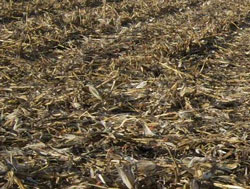Purdue University researchers have found that dividing up corn stalks may be the way to conquer in the quest for cellulosic ethanol efficiency.
 A research team discovered that when corn stover is processed to make ethanol, three distinct parts of it – the rind, pith and leaves – break down in different ways.
A research team discovered that when corn stover is processed to make ethanol, three distinct parts of it – the rind, pith and leaves – break down in different ways.
Cellulosic ethanol is created by using enzymes to extract sugars from cellulosic feedstocks, such as corn stover, grasses and woods, and then fermenting and distilling those sugars into fuels. Stover’s pith, the soft core that makes up more than half the weight of a corn stalk, is the easiest for enzymes to digest, according to the findings in two papers published in the journal Biotechnology and Bioengineering. Rind is the most difficult, while leaves fall in between. Significant amounts of lignin, the rigid compound in plant cell walls, make the cellulose resistant to hydrolosis, a process in which cellulose is broken down into sugars.

